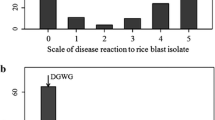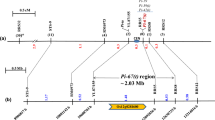Abstract
The race IE-1k of Magnaporthe oryzae recovered from the Southern US overcomes the resistance (R) gene Pita. The objectives of the present study were to identify and tag R genes to IE-1k for rice breeding. TM2, S1, 94071, and B isolates of the race IE-1k were used to identify and map R genes from a resistant indica rice cultivar Zhe733 using a recombinant inbred line population from a cross of the genetic stock KBNTlpa1-1 and Zhe733. The ratio of 3 resistant:1 susceptible in 162 RIL of an F10-11 KBNTlpa1-1/Zhe733 (K/Z) population indicated that two major R genes in Zhe733 confer resistance to IE-1k. A total of 118 polymorphic simple sequence repeat markers were analyzed in 162 F10-11 individuals of the K/Z population to determine chromosomal locations of the loci conferring resistance to race IE-1k using composite interval mapping. Two major R genes temporarily designated as Pi42(t) and Pi43(t) each providing complete resistance to IE-1k were identified on chromosomes 8 and 11, respectively. RILs containing Pi42(t) and Pi43(t) were also resistant to other US races IB-1, IB-45, IB-49, IB-54, IC-17, IE-1, IG-1, and IH-1. The Pi42(t) gene was mapped between RM310 and RM72, and the location of Pi43(t) was closely associated with two flanking SSR markers RM1233 and RM224 on chromosome 11 in a chromosomal region carrying the resistance gene Pi1. Two molecular markers RM72 and RM1233 identified in this study should be useful for fine mapping and for facilitating incorporation of Pi42(t) and Pi43(t) into advanced breeding lines by marker-assisted selection.

Similar content being viewed by others
References
Berruyer R, Adreit H, Milazzo J, Gaillard S, Berger A, Dioh W, Lebrun MH, Tharreau D (2003) Identification and fine mapping of Pi33, the rice resistance gene corresponding to the Magnaporthe grisea avirulence gene ACE1. Theor Appl Genet 107:1139–1147. doi:10.1007/s00122-003-1349-2
Correll JC, Harp TL, Guerber JC, Lee FN (2000) Differential changes in host specificity among MGR586 DNA fingerprint groups of Pyricularia grisea. In: Tharreau D (ed) International symposium on rice blast disease, 2nd edn. Kluwer, Dordrecht, pp 234–242
Couch BC, Kohn LM (2002) A multilocus gene genealogy concordant with host preference indicates segregation of a new species, Magnaporthe oryzae, from M. grisea. Mycologia 94:683–693. doi:10.2307/3761719
Fjellstrom RG, Conaway-Bormans CA, McClung AM, Marchetti MA, Shank AR, Park WD (2004) Development of DNA markers suitable for marker assisted selection of three Pi genes conferring resistance to multiple Pyricularia grisea pathotypes. Crop Sci 44:1790–1798
Fuentes JL, José Correa-Victoria F, Escobar F, Prado G, Aricapa G, Duque MC, Tohme J (2007) Identification of microsatellite markers linked to the blast resistance gene Pi-1(t) in rice. Euphytica 160:295–304. doi:10.1007/s10681-007-9497-0
Jia Y, Valent B (2007) Molecular aspects of rice blast resistance: insights from structural and functional analysis of the Pi-ta and AVR-Pita gene pair. In: Data S (ed) Rice improvement in the genomic era. CRC Press, Taylor & Francis Group, Boca Raton, FL, pp 207–236
Jia Y, Wang Z, Singh P (2002) Development of dominant rice blast resistance Pi-ta gene markers. Crop Sci 42:2145–2149
Jia Y, Redus M, Wang Z, Rutger JN (2004a) Development of a SNLP marker from the Pi-ta blast resistance gene by tri-primer PCR. Euphytica 138:97–105. doi:10.1023/B:EUPH.0000047079.42768.4d
Jia Y, Wang Z, Fjellstrom RG, Moldenhauer KAK, Azam MA, Correll J, Lee FN, Xia Y, Rutger JN (2004b) Rice Pi-ta gene confers resistance to the major pathotypes of the rice blast fungus in the US. Phytopathology 94:296–301. doi:10.1094/PHYTO.2004.94.3.296
Jia Y, Wamishe Y, Jia MH, Lin MJ, Eizenga GC, Gibbons JW, Moldenhauer KK, Correll JC (2005) Two major resistance genes confer resistance to race shift isolates overcoming blast resistance gene Pi-ta. Rice Research Studies 2004. Arkansas Agricultural Experiment Station, Fayetteville, AR, pp 91–95
Lee FN, Cartwright RD, Jia Y, Correll JC, Moldenhauer KAK, Gibbons JW, Blytt V, Zhou E, Boza E, Seyran E (2005) A preliminary characterization of the rice blast fungus on ‘Banks’ rice. In: Wells BR, Norman RJ, Meullenet JF (eds) Rice Research Studies 2004. Arkansas Agricultural Experiment Station, Arkansas
Liu B, Zhang S, Zhu X, Yang Q, Wu S, Mei M, Mauleon R, Leach J, Mew T, Leung H (2004) Candidate defense genes as predictors of quantitative blast resistance in rice. Mol Plant Microbe Interact 17:1146–1152. doi:10.1094/MPMI.2004.17.10.1146
Liu XQ, Wang L, Chen S, Lin F, Pan QH (2005) Genetic and physical mapping of Pi36(t), a novel rice blast resistance gene located on rice chromosome 8. Mol Genet Genomics 274:394–401. doi:10.1007/s00438-005-0032-5
Liu X, Lin F, Wang L, Pan Q (2007) The in Silico map-based cloning of Pi36, a rice coiled-coil-nucleotide-binding site-leucine-rich repeat gene that confers race-specific resistance to the blast fungus. Genetics 176:2541–2549. doi:10.1534/genetics.107.075465
Liu G, Bernhardt JL, Jia MH, Wamishe YA, Jia Y (2008) Molecular characterization of the recombinant inbred line population derived from a japonica-indica rice cross. Euphytica 159:73–82. doi:10.1007/s10681-007-9459-6
McClung AM, Fjellstrom RG, Bergman CJ, Bormans CA, Park WD, Marchetti MA (2004) Registration of ‘Saber’ rice. Crop Sci 44:693–694
Nagato Y, Yoshimura A (1998) Report of the committee on gene symbolization, nomenclature and linkage group. Rice Genet Newsl 15:12–74
Ou SH (1985) Rice diseases, 2nd edn. Commonwealth Mycological Institute, Kew Surrey, pp 109–201
Rutger JN, Tai T (2005) Registration of K/Z mapping population of rice. Crop Sci 45:2671–2672. doi:10.2135/cropsci2005.0216
Song WY, Wang GL, Chen LL, Kim HS, Pi LY, Holsten T, Gardner J, Wang B, Zhai WX, Zhu LH, Fauquet C, Ronald P (1995) A receptor kinase-like protein encoded by the rice disease resistance gene, Xa 21. Science 270:1804–1806. doi:10.1126/science.270.5243.1804
Tabien R, Li Z, Paterson A, Marchetti M, Stansel J, Pinson SRM (2004) Mapping QTLs for field resistance to the rice blast pathogen and evaluating their individual and combined utility in improved varieties. Theor Appl Genet 105:313–324
Talukder ZI, Tharreau D, Price AH (2004) Quantitative trait loci analysis suggests that partial resistance to rice blast is mostly determined by race-specific interactions. New Phytol 162:197–209. doi:10.1111/j.1469-8137.2004.01010.x
Valent B (1997) The rice blast fungus, Magnaporthe grisea. In: Caroll GC, Tudzynoski P (eds) Plant relationships. Springer, Berlin, pp 37–54
Valent B, Farrall L, Chumley FG (1991) Magnaporthe grisea genes for pathogenicity and virulence identified through a series of backcrosses. Genetics 127:87–101
Van Ooijen JW (2006) JoinMap® 4, Software for the calculation of genetic linkage maps in experimental populations. Kyazma B. V., Wageningen
Wang S, Basten CJ, Zeng ZB (2007) Windows QTL Cartographer 2.5. Department of Statistics, North Carolina State University, Raleigh
Yan ZB (2004) Inheritance of resistance in rice cultivars of USA to Pyricularia grisea races IE-1K, IB-33, IB-49 and IC-17. Acta Agronom Sin 30:872–877
Zhou E, Jia Y, Correll J, Lee FN (2007) Instability of the Magnaporthe oryzae avirulence gene AVR-Pita alters virulence. Fungal Genet Biol 44:1024–1034. doi:10.1016/j.fgb.2007.02.003
Acknowledgments
The authors thank the Arkansas Rice Research and Promotion Board for partial financial support, Michael Lin, Tony Beaty, Kristen Pratt, Drs. Joseph Kepiro, Hesham Agrama, Robert Fjellstrom (USDA-ARS DB NRRC) for excellent technical support, Lorie Bernhardt and Dr. J. Neil Rutger of Genetic stock-Oryza (GSOR) collection of DB NRRC for providing the RIL population of the cross of KBNTlpa1-1 and Zhe733, and Dr. Thomas Mitchell (Department of Plant Pathology, Ohio State University) and Dr. Stephen Neate (Department of Plant Pathology, North Dakota State University) for technical comments. This report is part of the NP301 project # 6225-21220-002-00 of USDA-ARS and is also supported by National Science Foundation under Grant No. 0638820, USA.
Author information
Authors and Affiliations
Corresponding author
Additional information
The authors S. Lee and Y. Wamishe contribute equally to this work.
Rights and permissions
About this article
Cite this article
Lee, S., Wamishe, Y., Jia, Y. et al. Identification of two major resistance genes against race IE-1k of Magnaporthe oryzae in the indica rice cultivar Zhe733. Mol Breeding 24, 127–134 (2009). https://doi.org/10.1007/s11032-009-9276-9
Received:
Accepted:
Published:
Issue Date:
DOI: https://doi.org/10.1007/s11032-009-9276-9




